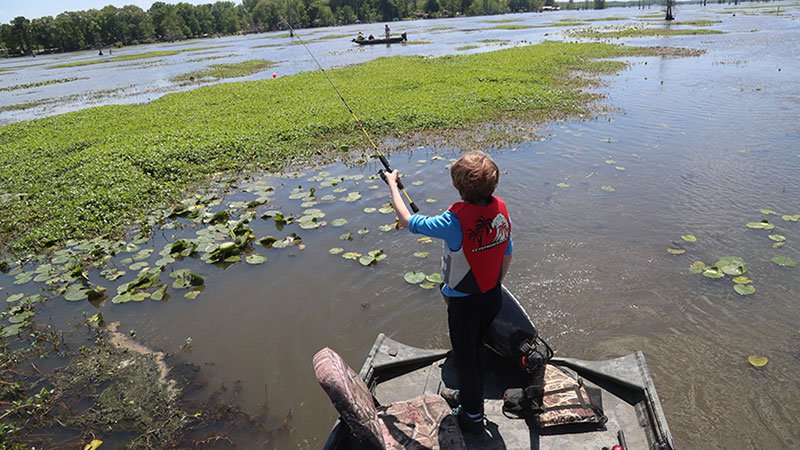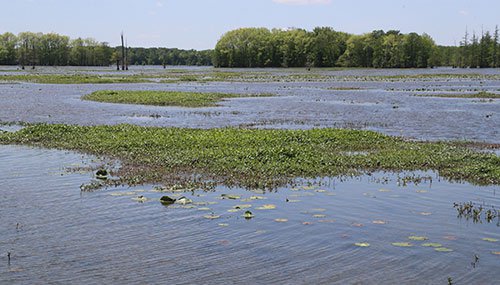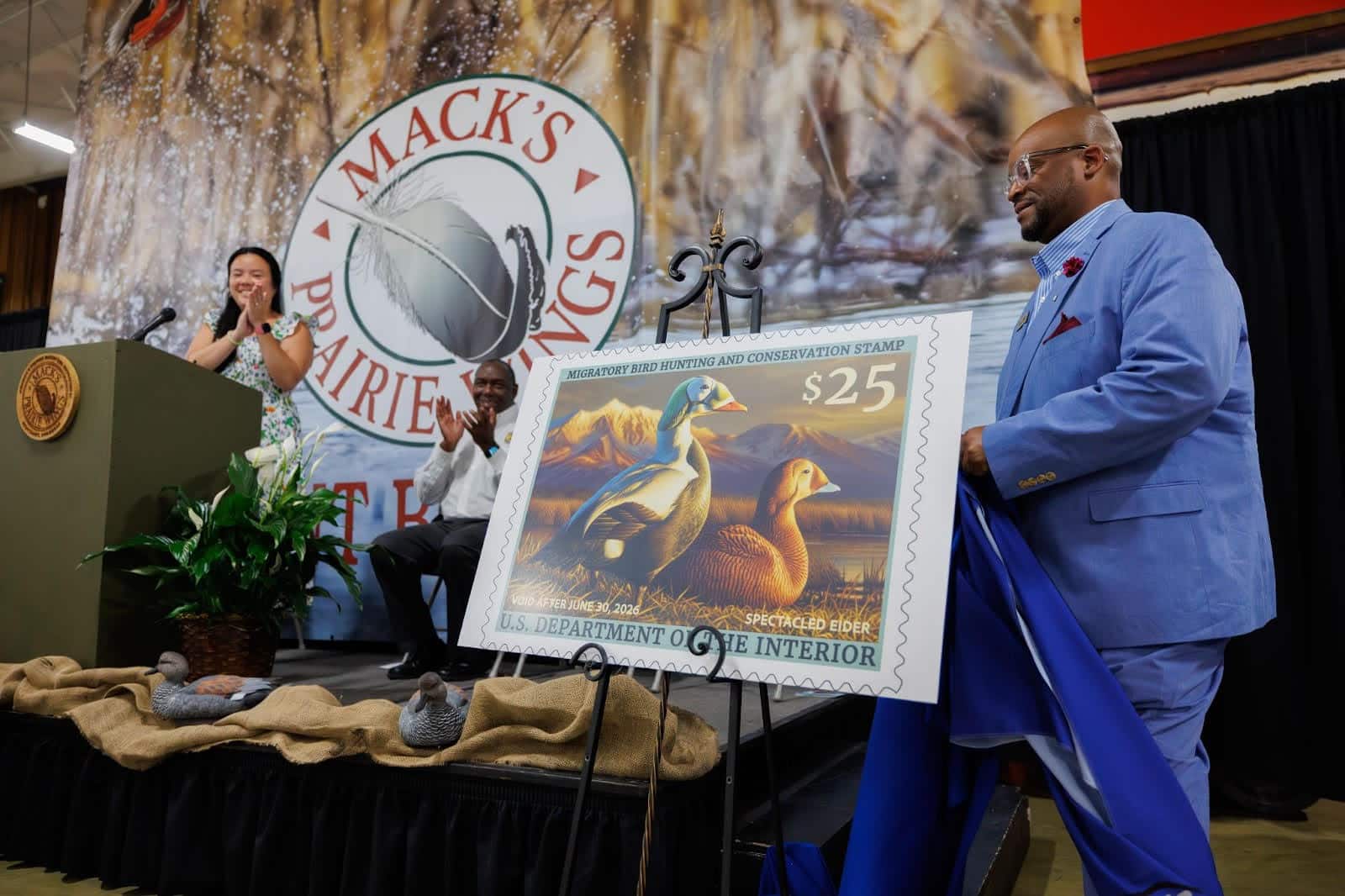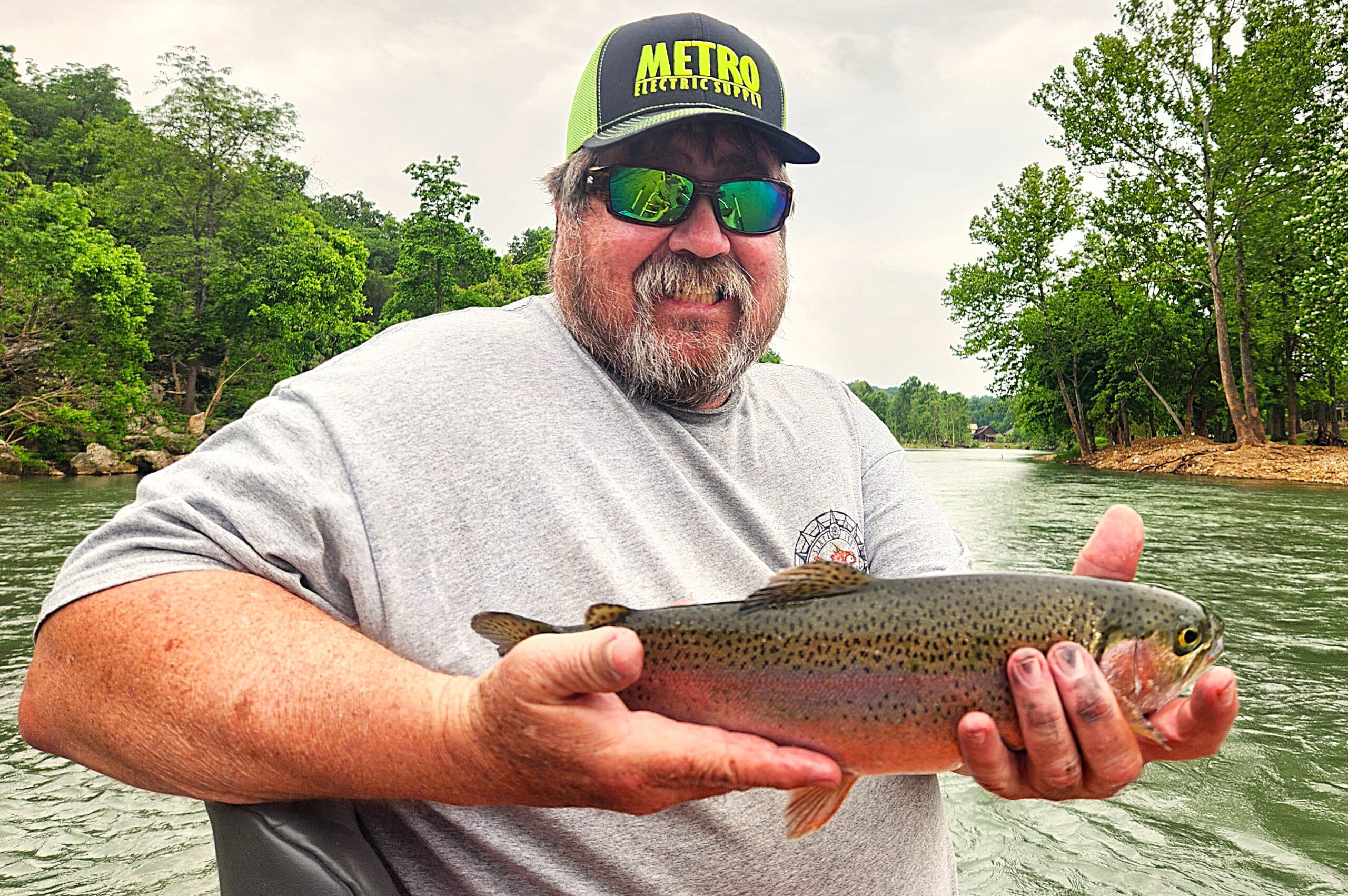AGFC tackles Lake Conway’s alligatorweed with a triple dose
BY Jim Harris
ON 05-20-2020

May 20, 2020
Jim Harris
Managing Editor Arkansas Wildlife Magazine
MAYFLOWER – Left unattended, the nonnative, invasive vegetation known as alligatorweed is a lake and fishing disaster waiting to happen. At least that’s how Matt Horton, an Arkansas Game and Fish Commission Fisheries biologist describes it when he discusses the herbicide application process underway at Craig D. Campbell Lake Conway Reservoir.
“Alligatorweed can double in mass every 30 days,” Horton says. “And, Lake Conway having as many nutrients as it has, the plants grow very fast. They’ll quickly overtake native plant species. They’ll reduce water quality by shading out the sunlight. You’ll have a drop in pH, you’ll lose spawning habitat for fish. You can’t drive a boat through it, you can’t fish in it, it’s too thick.
“So, it hinders fishing and boating access, access to private piers and boathouses, public fishing piers, reduces water quality and, if left unattended, in time it would have an impact on the fish population. And that’s the gist of not doing anything about an invasive aquatic plant.”

On the northeast end of Lake Conway, where Palarm Creek flows into the lake, anglers and boaters can note literal floating islands of alligatorweed, something that looks like large clumps of holly or, when it flowers, like white clover. Things are better this year, though, Horton notes. Last year, he estimates, the lake had about 250 acres of alligatorweed that could be found around the entire shoreline, with the vast majority spotted in the mouth of Palarm and Caney creeks, two of the primary tributaries that drain into Lake Conway. Those areas also are shallower than most of the lake.
Two years into a newer approach – applying herbicides in May, July and September – the areas of alligatorweed appear to be diminishing. Horton estimates there are about 150 acres of the plant this spring. But alligatorweed is so persistent, it’s not going away with just a few sprayings.
The spray used in the May application by Sprayco, the AGFC’s Houston-based contractor, called Garlon 3A, is a broadleaf selective herbicide. None of the applications will harm fish and other aquatic species or other plants that the biologists want in the lake. However, as residents around Lake Conway have been told the past two years, the aquatic-approved herbicide application requires a 120-day federal restriction from using the lake water for watering yards and gardens. The latest restriction runs until Jan. 31, 2021.
With four airboats, Sprayco spot-treated all the visible alligatorweed. “They’re not just spraying herbicide everywhere or injecting it into the water, they’re just treating the plants they see … When they spray it on the plant, it absorbs into the plant within a matter of a few hours. It dilutes in the water,” Horton said.
Alligatorweed was first found on Lake Conway in 2000, Horton said. Beginning in 2008, the biologists spot-treated the plant but that didn’t slow its growth. Horton says that some aquatic plants could be treated with biological controls, such as with the introduction of grass carp, and several thousand grass carp were introduced near the Palarm boat ramp. They will love dining on the 800 or so acres of coontail that have sprung up there, but they won’t eat alligatorweed. A South American insect, the alligatorweed flea beetle, which feasts on the plant where both are native, in the southern hemisphere, thrives also in south Texas, Florida and Louisiana, but AGFC biologists learned after trying it that the insect couldn’t tolerate Arkansas’s colder climate.
But obviously alligatorweed can thrive, as Horton notes it continues to spread northward and outpace its biological predators.
To stop it, Arkansas has taken a chemical approach, with the annual three-times-a-year application its latest weapon. It’s understood, Horton added, that no herbicide can kill alligatorweed in one application. Instead, he said, “We’re basically starving the plant over time. We’re reducing its resources and ability to regenerate the following year. So, if we can keep it weak throughout the growing season and use the most effective herbicide on it right before it goes dormant in the fall, it can’t take any energy reserves into the root system. When it tries to regenerate in the spring, it won’t have enough energy to, and the plant will die. But it will take a few years of doing that, especially on older, more established plants, to knock them back.”
It works like this: Horton says the biologists want the initial spraying, in May, to kill as much of the plant as it can, then it’s given time to regrow so it can be treated again in about three months. “You want to get three applications in a year to knock the plant back,” he said. “If you don’t, it gets enough time to regenerate before it goes dormant and it will come back the next year.”
The key, he said, is consistency in the spraying. One missed cycle sets the plan back. Funding for invasive aquatic vegetation control has had to see a boost in the last two years in the entire Fisheries Division, and that has made it possible to treat Lake Conway with this new three-times-per-year approach. Horton notes that the amount of money that once funded his entire six-county fisheries district budget nearly equals the cost of fighting alligatorweed in one lake.
Other nonnative invasive vegetative species have hit other Arkansas lakes of late and caught the AGFC’s attention. Giant salvinia, already a big problem for lakes in Louisiana and Texas, showed up in recent years in Lake Erling and then around last Christmas at Lake Columbia, both near Magnolia. Working with the AGFC and several other Columbia County agencies, a contractor began spraying for the giant salvinia earlier this year. Water hyacinth is another target of the agency that has seen a reduction in several lakes through treatments led by AGFC biologist Kris Nault in southeast Arkansas.
Jason Olive, the AGFC’s assistant chief for Fisheries, said that in fiscal year 2019, the agency spent $204,521 spraying for invasive aquatic vegetation. So far in fiscal 2020 the total is $129,027 but with the division’s two busiest months left in the period, with the total expected to climb over $200,000 again.
As of 2019, Olive noted, the Louisiana Department of Wildlife and Fisheries has spent in the neighborhood of $7 million-$9 million per year on aquatic vegetation control, with nearly $1 million per year devoted to Lake Bistineau, about 30 miles south of the border with Arkansas. The Texas Parks and Wildlife Department spends a little more than $1 million, he said.
“Both states have government agencies, like river authorities or lake commissions, that are separate from their game and fish agencies that also spend money on vegetation control, so there is no telling what their state governments spend altogether,” Olive said. “They’re not like Arkansas, where the AGFC is the only game in town.” He notes that while the budget information for spraying wasn’t available, the Mississippi Department of Wildlife, Fisheries and Parks has a full-time spraying team. At the vast Ross Barnett Reservoir north of Jackson, the Pearl River Authority pays for vegetation spraying where the appearance of giant salvinia recently made headlines.
Horton said, “The spread of invasive species can happen in such a short amount of time. So, it just shows the impact one of these plants can have and the importance of staying on top of it and making sure they don’t become prevalent in our water bodies.”
Boaters, including those who fish or those hunting waterfowl, are encouraged to clean, drain and dry their boats and equipment, especially if they move from one lake to another. Alligatorweed is thought to have made its way into Lake Conway via the Arkansas River, but Horton says it’s believed that waterfowl may ingest the seeds of the plant and disperse them elsewhere. It could spread to other water bodies if the plant clings to a boat motor propeller or a boat trailer. When it’s dormant in winter, alligatorweed might not even be noticed by a waterfowl hunter picking up decoys after a hunt and taken along elsewhere.
It can spread easily, Horton said.
“The unique thing about alligatorweed is, it can be rooted into the ground,” he said. “If it hits the bank it’s going to grow roots into the ground, but if a piece breaks off and floats in the water, the stems all of a sudden become hollow, they change. The plant is buoyant and any fragment of the plant where the leaf grows, or a piece of the root, will create a new plant.
“Say you’re driving your boat with your trolling motor or boat motor through a little patch of alligatorweed. All those little pieces that come off will start a new plant. They can free float in the water without having to be rooted, but as soon as they hit the bank, they’ll grow roots than go as much as 3 feet into the ground and they’re permanently established in that location.”
Landowners around the lake that use weed-eaters or mowers on established alligatorweed on the edge of the shoreline can spread it when they chop it up – the leaves will root again on their land, or they will hit the water and spread that way. “It’s an incredibly hard plant to manage and it’s one of the things that we now have to deal with,” Horton said.
Lake Conway is not alone with this invasive vegetation now. Alligatorweed was documented in Beaverfork Lake and Lake Overcup in 2014, Horton said. Lake Overcup has the same spraying program and watering restrictions for lakeshore residents as Lake Conway has, Horton noted. In 2019, he says, biologists spotted the first example of alligatorweed growing in Harris Brake Lake, in Perry County.
“So, it’s getting spread around either through people with boats or through waterfowl,” he said. “Every time it gets in a new lake, it’s almost impossible to eradicate. You just have to manage its densities every year. And every new lake it gets into means more money we have to spend on controlling the plant where we would have used that money for fish habitat/fish management work.”
Lake Conway can only stay a vibrant fishery as long as the AGFC continues slowing the alligatorweed growth and reducing its size. The fishery itself appears strong, Horton said.
“Right now, the major game fish species are pretty much in their prime,” he said. “Our largemouth bass sampling and crappie sampling have indicated that the fish have higher-than-average relative weights or they are in above-average condition as far as their weight for the length of the fish, and we’re seeing double-digit (pounds) largemouth bass being caught this year and crappie over 3 pounds. The shad production in the lake has been really high the last few years, so there is ample food. It seems like even the catfish, the bream … I’m hearing they’re catching larger bluegill than they did last year, so it seems everything is doing really well right now.”
Recent News
Subscribe to Our Weekly Newsletter E-mails
Don’t miss another issue. Sign up now to receive the AGFC Wildlife Weekly Newsletter in your mailbox every Wednesday afternoon (Waterfowl Reports are published weekly during waterfowl season and periodically outside the season). Fishing Reports arrive on Thursdays. Fill in the following fields and hit submit. Thanks, and welcome!


